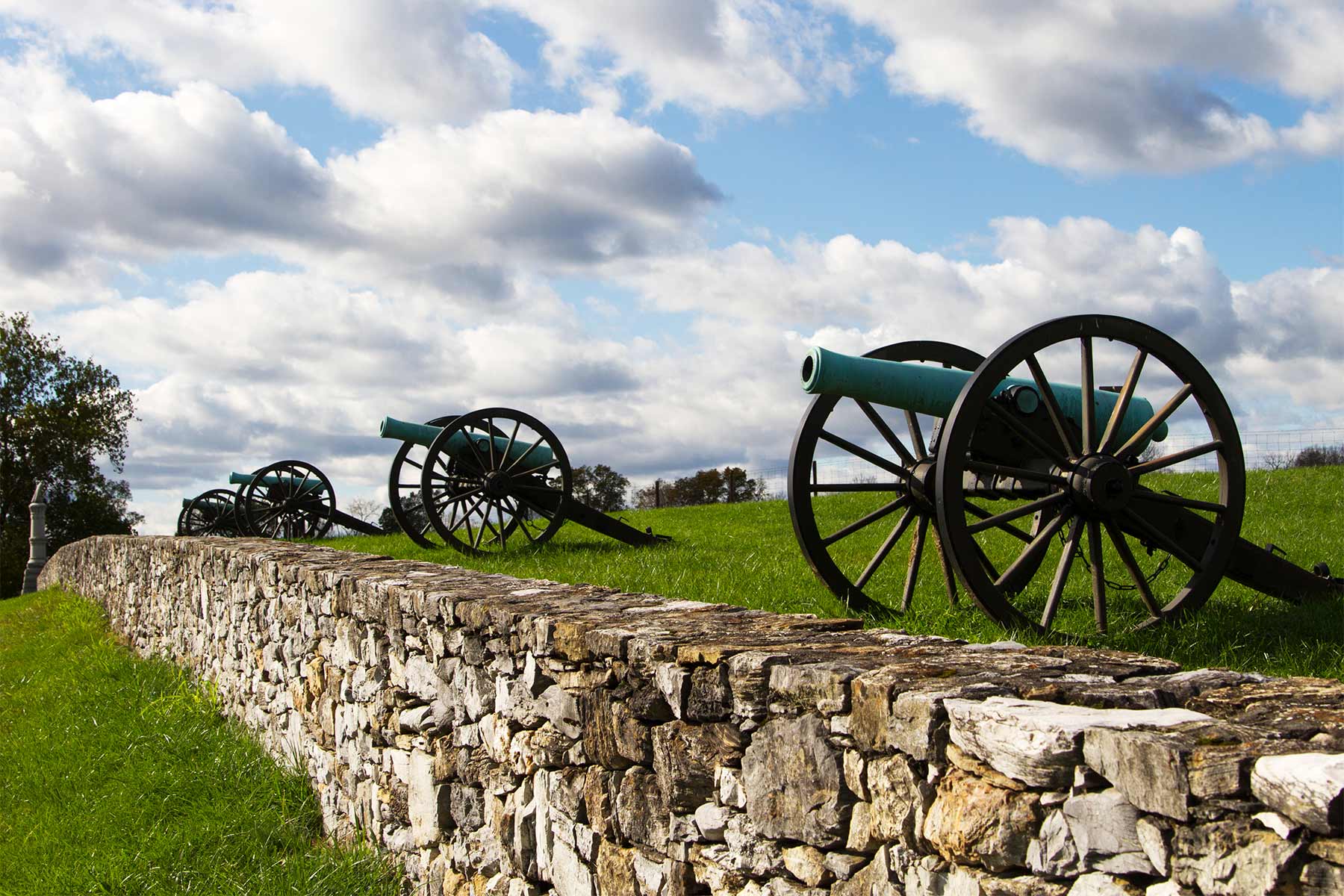
Article Summary: Maryland National Parks
Maryland National Parks! In this article, we feature some incredible national park sites in the great state of Maryland. We’ve got 27 national park sites for you to see on your next visit to the Old Line State.
As someone who has lived on the east coast for the past four decades I have spent countless hours visiting Maryland’s beautiful national park sites.
I’ve been to so many of these amazing places since retiring from teaching in 2018. Did I mention that I taught history? I spent a lifetime teaching about the history behind these momentous sites. Then I got to see them firsthand. And now I’m sharing the stories of these incredible places with you. It doesn’t get any better than that!
These Maryland National Parks include amazing historic sites, incredible monuments, beautiful parks, legendary trails, and much more.

So, What Is A National Park?
We get asked that question a lot because there’s a difference between a “national park” and a “national park site.” To help you understand that difference you might want to check out our article titled: What Is A National Park Really?
If you’re planning a trip to the Old Line State then one book that I highly recommend is: GREATER THAN A TOURIST- BALTIMORE MARYLAND USA: 50 Travel Tips from a Local by Zoe Scurletis.
We’ll give you 27 wonderful reasons why you’ll want to make Maryland your next vacation destination.

Table Of Contents: Maryland National Parks
Maryland National Parks
- National Parks of Maryland
- More Maryland National Parks
- More Maryland National Parks
- More Maryland National Parks
- More Maryland National Parks
- Still More Maryland National Parks
- Check Out Our Great Smoky Mountains Film
- Maryland National Parks FAQ
- Meet The Parks Brothers
- Map Of Maryland National Park Sites
- List Of Maryland National Park Sites
- We Hope You’ll Follow Our Journey
National Parks of Maryland
1. Antietam National Battlefield
I’m a retired history teacher who likes nothing better than to pack up his car and go off in search of America’s past. And the Maryland National Parks have a lot to offer in this department!
Beginning with the Battle of Antietam which featured the bloodiest single day in American history. It was one of the pivotal battles of the American Civil War. President Abraham Lincoln was desperate for a Union victory against Confederate General Robert E. Lee and his Army of Northern Virginia.
Many historians consider this battle to be a stalemate. Lee’s invasion of the North was stopped, however, and this was decisive enough for Lincoln to move forward with his historic Emancipation Proclamation.
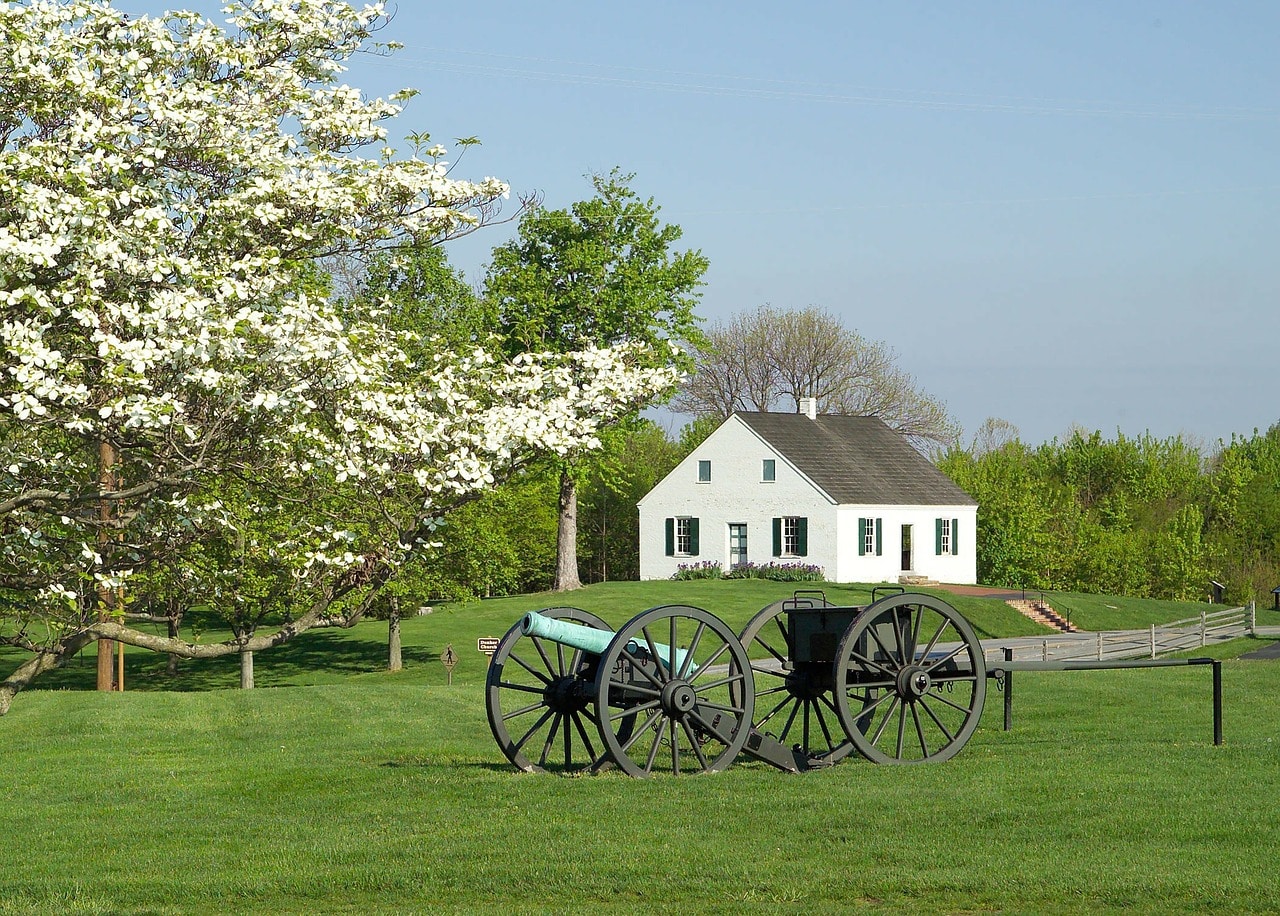
Six Other Ways That Antietam Changed The Course Of History
- Robert E. Lee is the military genius who confounded one northern general after another. Lee was fresh off of his victory in the Second Battle of Bull Run. At Antietam, his plan was to invade the north. He was repelled, however, and would not attempt another invasion of the North until the Battle of Gettysburg in 1863.
- A string of Confederate victories in the summer of 1862 had brought France and Great Britain close to recognition of the Confederate States of America. This would have been devastating for the Union cause. Lee’s inability to win a decisive victory at Antietam halted this momentum towards diplomatic recognition.
- The Union’s ability to stop Lee and force him to withdraw lifted northern morale.
- Antietam was one of the first battles in history to feature photographic images of twisted bodies littering the devastated landscape and stacked in heaps like slaughtered livestock. These images brought the horror of war home to the civilian population.
- The Union’s ability to stop Lee helped President Lincoln’s Republican Party in the 1862 elections. Democrats had been highly critical of the President’s conduct of the war. They were hoping to make significant political gains. Republicans, however, actually gained seats in the Senate and maintained a majority in the House.
- While Lee was stopped, Union Commander George McClellan refused to pursue Lee’s Army as Lincoln felt he should have. For McClellan, this was the beginning of the end as Lincoln began to search for a new commander.

CHECK OUT: 10 BEST Civil War Sites In America
Take A Deeper Dive
As a retired history teacher, my mantra is “So many books, so little time.”
So many wonderful books have been written on the American Civil War. I have three recommendations for the Battle of Antietam.
A Fierce Glory: Antietam–The Desperate Battle That Saved Lincoln and Doomed Slavery by Justin Martin, Antietam Revealed: The Battle of Antietam and the Maryland Campaign As You Have Never Seen It Before by Dennis Frye and Landscape Turned Red: The Battle of Antietam by Stephen Sears.
Things To Do At The Antietam National Battlefield
Here are some things to do at Antietam National Battlefield:
- Take a guided tour: The park offers a variety of guided tours led by park rangers and licensed battlefield guides. These tours provide a detailed overview of the battle and the historic sites on the battlefield.
- Visit the visitor center: The visitor center features exhibits, films, and interactive displays that provide an overview of the battle and its significance. The center also includes a museum store with books, souvenirs, and other items related to the battle.
- Explore the battlefield: The park features a network of hiking trails and driving routes that allow visitors to explore the battlefield and its historic landmarks. Highlights include the Dunker Church, the Sunken Road, and Burnside’s Bridge.
- Attend special events: The park hosts a variety of special events throughout the year, including living history programs, battlefield hikes, and commemorative ceremonies.
- Picnic: The park has several picnic areas where visitors can relax and enjoy a meal or snack. These areas are equipped with tables, grills, and restroom facilities.
- Ranger programs: The park offers a variety of ranger-led programs, including talks, walks, and demonstrations. These programs provide visitors with an opportunity to learn about the history and significance of the battlefield in a more interactive and engaging way.
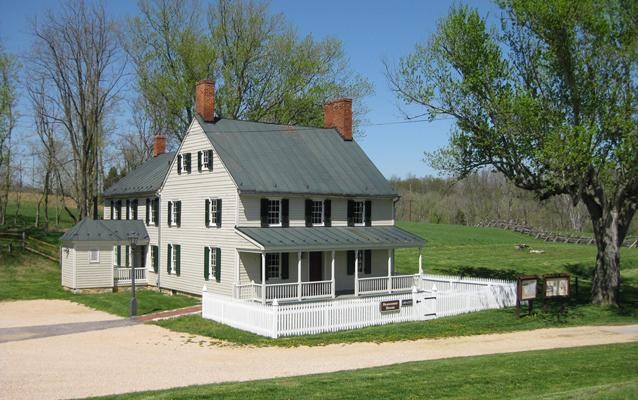
The Pry House Field Hospital Museum | The Birthplace Of Modern Emergency Medicine
Another place that you should check out is the Pry House Field Hospital Museum. The Pry House sits on Antietam National Battlefield near Sharpsburg, Maryland. It was built in 1844 as the home of Phillip and Elizabeth Pry and their six children.
During the Battle of Antietam in September 1862, the house served as headquarters for General George McClellan, as well Major Jonathan Letterman, the army’s medical director.
Antietam is the birthplace of modern emergency medicine. It was here that Letterman developed an efficient system for securing, evacuation, and treating casualties. Now called the Letterman Plan, it remains the basis of medical response on battlefields and in disaster situations around the world.
Today the Pry House is home to the Pry House Field Hospital Museum, a satellite museum of the National Museum of Civil War Medicine. The museum includes two floors of exhibits with original artifacts and text panels discussing battlefield medicine and field hospitals of the Civil War, especially Antietam.
Visitors will see fascinating exhibits including a re-creation of an operating theater, interpretive panels and objects relating to the care of wounded and the effects on the civilian population in the area as well as information about the Pry House.
There’s a wonderful book that I recommend regarding this fascinating topic. It’s Surgeon in Blue: Jonathan Letterman, the Civil War Doctor Who Pioneered Battlefield Care by Scott McGaugh.
.jpg)
RELATED: 11 BEAUTIFUL Alabama National Parks
2. Appalachian National Scenic Trail
Need a good stretch of the legs? When you visit the Maryland National Parks you can explore the longest hiking trail in the world?
The Appalachian National Scenic Trail, also known as the Appalachian Trail or simply the AT, is a 2,190-mile long footpath that extends from Springer Mountain in Georgia to Mount Katahdin in Maine.
The trail passes through 14 states and crosses through several diverse landscapes, including forests, meadows, and rocky ridges.
The Appalachian Trail was first conceived in the 1920s, and over the years, volunteers and government agencies have worked to build and maintain the trail, making it one of the longest hiking trails in the world.
The trail is now a unit of the National Park System and is protected and managed by the National Park Service and the Appalachian Trail Conservancy.
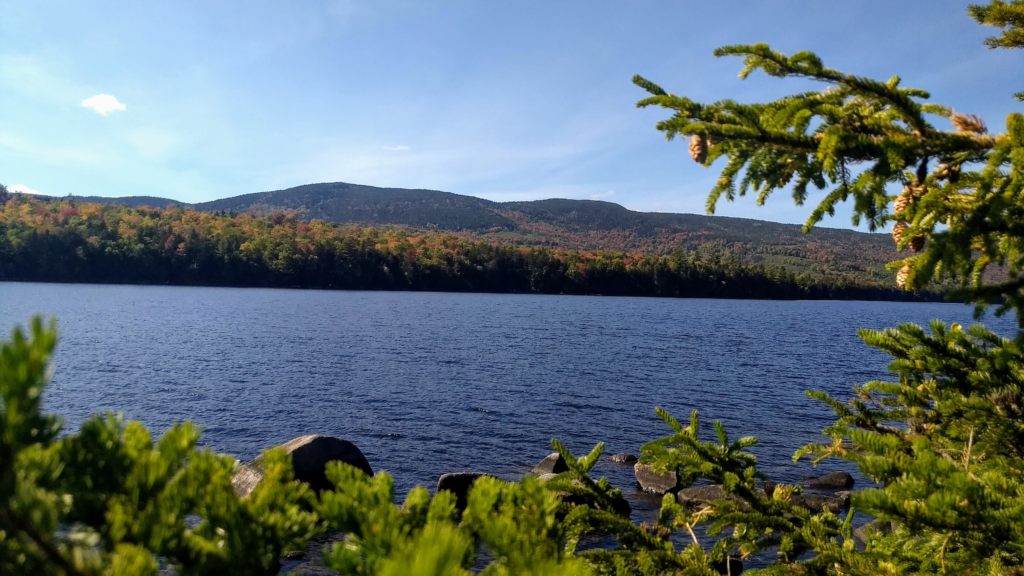
A Chance To Experience The Natural Beauty Of The Eastern United States
The Appalachian Trail offers visitors a chance to experience the natural beauty of the eastern United States, from the rolling hills of Georgia to the rugged peaks of Maine. The trail is used by thousands of people each year for hiking, backpacking, and other outdoor recreation.
In addition to the scenic beauty, the trail is also rich in cultural and historical resources, passing by small towns, historic sites, and other landmarks that offer insight into the history and culture of the region.
Whether you are a seasoned hiker or simply looking for a leisurely walk in the woods, the Appalachian National Scenic Trail offers something for everyone, providing an unforgettable experience of the beauty and diversity of the eastern United States.
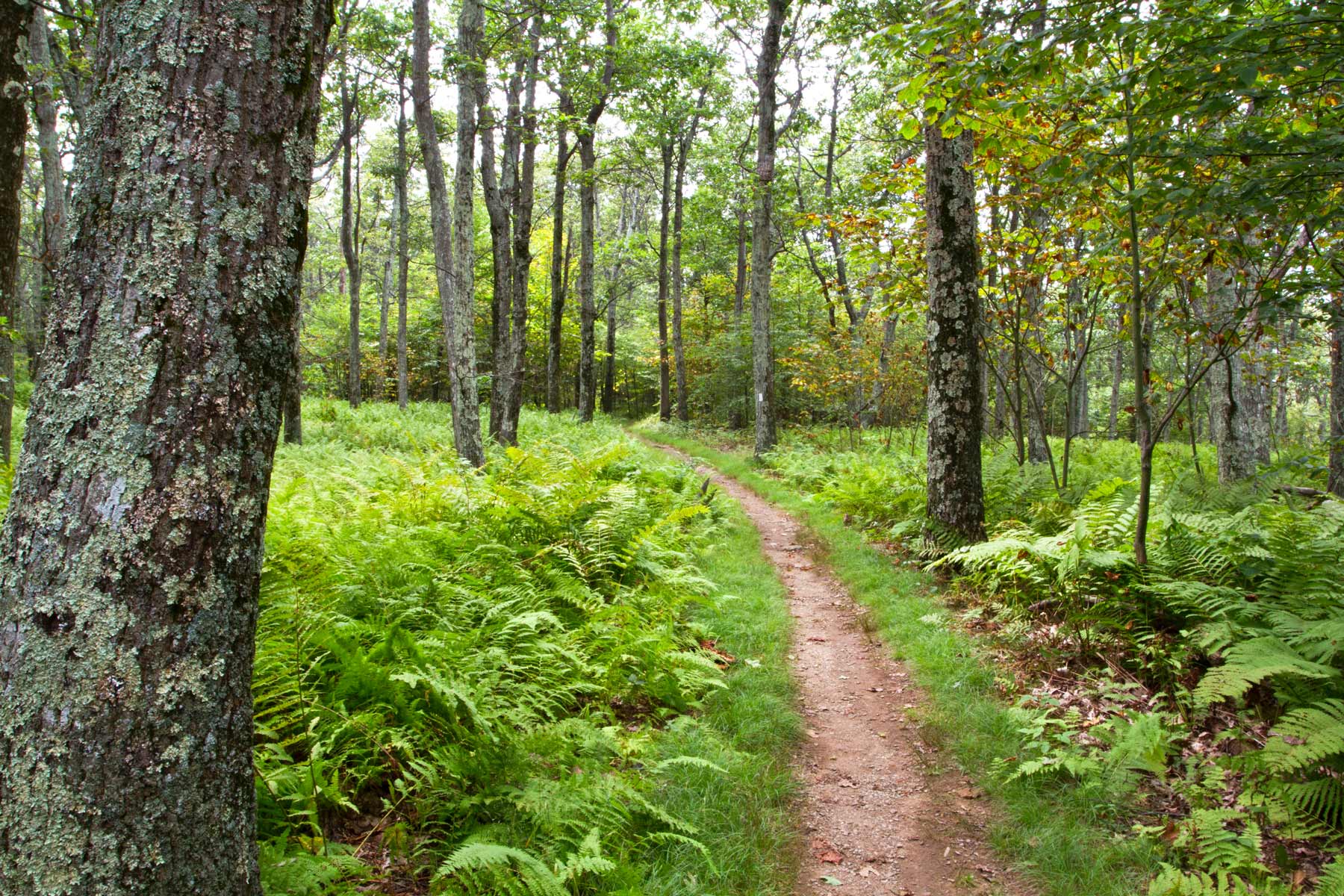
3. Assateague Island National Seashore
It’s not just history or hiking trails that you’ll discover among the Maryland National Parks. There’s also one of the most beautiful seashores in America. Of course I’m referring to the Assateague Island National Seashore.
As a first-time visitor, you should stop at the visitor center to see exhibits and obtain information about the many recreational activities and natural features in the seashore.

So Many Wonderful Outdoor Activities To Choose From
A list of the outdoor activities include:
- Biking: Cyclists may travel to Assateague over a bicycle-pedestrian bridge and follow a paved bike path along Bayberry Drive through 4 miles of island habitat.
- Camping: Reservations are required from March 15 through November 15. There are five campsites to choose from including one which accommodates horses.
- Crabbing: Be sure to bring a hand line or string with a weight and/or a crabpot or trap bait (chicken necks, bait fish), net with long handle, ruler to measure the crabs and a cooler with lid and ice.
- Hiking: Trails include Life of the Dunes, Life of the Forest and Life of the Marsh complete with trail guides.
- Horseback Riding: The national seashore does not offer horses for rent or horseback riding tours. Day use horseback riding is permitted in Maryland from October 9 through May 14. Riding is permitted on the beach only, east (ocean side) of the black and white posts.
- Fishing: Surf fishing has been a popular recreational activity on Assateague Island for generations. A license is required.
- Swimming: NPS Lifeguards supervise designated beach areas in Maryland and Virginia sections of Assateague. (Source: NPS)

RELATED: Whose Island Is It Anyway | A History & Guide To Cumberland Island
4. Baltimore-Washington Parkway
When I travel to the Maryland National Parks I love to take a scenic drive along one of America’s most picturesque parkways.
It’s a beautiful parkway which offers its travelers some wonderful adventures. There are several places to visit along the Baltimore-Washington Parkway.
It’s a highway that runs from Baltimore, Maryland to Washington D.C. The parkway was designed to provide a scenic and efficient route for travelers between the two cities, and was constructed in the mid-20th century as part of a larger effort to improve the highway system in the United States.
Construction on the Baltimore-Washington Parkway began in the 1930s, but was temporarily halted during World War II. Work on the parkway resumed in the late 1940s, and the road was finally completed in 1954.

It Was Influenced By The Ideas Of Frederick Law Olmstead
The Baltimore-Washington Parkway was one of the first highways to be designed specifically for scenic beauty, and was influenced by the ideas of landscape architect Frederick Law Olmsted.
The parkway features wide medians, large trees, and other landscaping elements, and is known for its scenic views of the surrounding forests and wetlands.
In addition to providing a scenic route for travelers, the Baltimore-Washington Parkway also serves as a valuable resource for recreational activities, including hiking, biking, and bird watching. The parkway is managed by the National Park Service and is part of the National Park System, and is protected and maintained as a scenic and natural resource.
The Baltimore-Washington Parkway is a unique and valuable asset, providing a beautiful and efficient route for travelers, as well as a scenic and natural resource for recreational activities. Its history and design reflect the changing attitudes towards transportation and the environment, and its enduring popularity is a testament to the value and beauty of this scenic highway.
Be Sure To Check Out The Green Belt Museum
As a history buff, one of my favorite places to visit is the City of Greenbelt and the Greenbelt Museum.
The Greenbelt Museum provides a gateway to the rich history and living legacy of Greenbelt, Maryland, an experimental cooperative community created in 1937 by Franklin D. Roosevelt’s New Deal.
While you’re there you can take a trip back in time.
The Museum offers tours of an original historic home, exhibits, public programs, educational programs for children, and walking tours of the historic town to visitors and the community.

RELATED: 12 AMAZING Georgia National Parks
More Maryland National Parks
5. Captain John Smith Chesapeake National Historical Trail
Captain John Smith was an English explorer who played an pivotal role in America’s founding. Smith served on the governing council of Jamestown, Virginia He led two voyages on the Chesapeake Bay.
Smith’s contact with native tribes and his Chesapeake Bay voyages, documented in maps and journals, helped early English colonists learn about the region that became their new home.
Things To Do On The John Smith Chesapeake National Historical Trail
The trail commemorates Captain Smith’s exploration of the Bay in 1607 through 1609, and is the nation’s first all-water national historic trail. It stretches over 3,000 miles and traverses most of the Chesapeake’s great rivers.
The trail is administered by the National Park Service. It connects with 16 National Wildlife Refuges, 12 National-Parks, and three other National Trails.
Trails I would recommend exploring include the following:
- The Billy Goat Trail-It’s a popular trail near Potomac, Maryland. This is a protected area designed to preserve the remains of the Chesapeake and Ohio Canals with the original structures still intact. The trail offers spectacular views of the Potomac River.
- Scott’s Run River Trail-It’s a wonderful area for nature trips, walking, and running. It features a beautiful waterfall. This is a beautifully wooded trail with a mix of inclines, flat areas, and areas with loose rocks.
- The Chesapeake and Ohio Canal Trail-It’s a popular trail that leads up to an overlook of the Great Falls. You will have wonderful views of the water and rock formations.
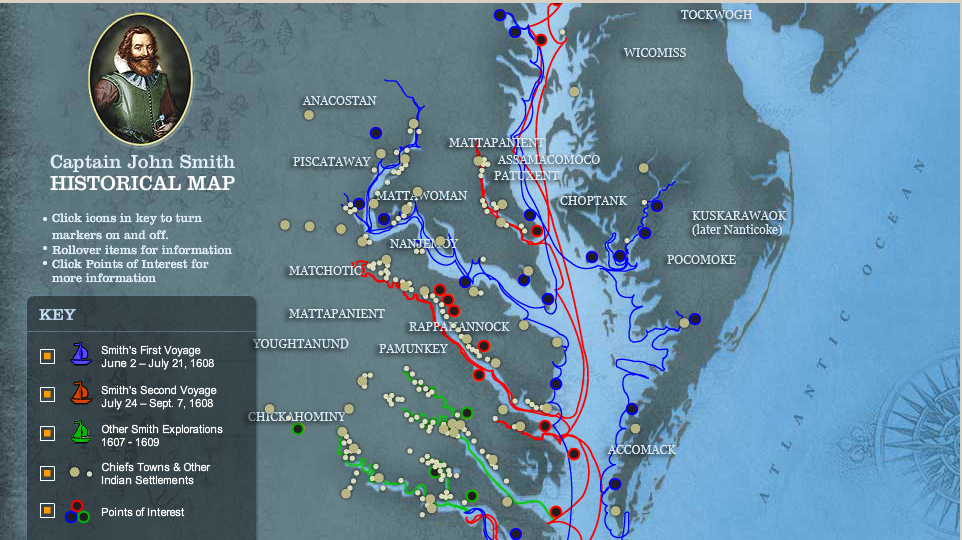
RELATED: Acadia National Park: An EPIC Guide To New England’s Premier Park
6. Catoctin Mountain Park
Catoctin Mountain Park is a unit of the National Park System located in Frederick County, Maryland. The park covers over 8,000 acres and includes the scenic Catoctin Mountain range, as well as the adjoining Blue Ridge Mountains.
Catoctin Mountain Park was established in 1936 as a federal recreational demonstration area, and was originally intended to provide job training and recreation opportunities for unemployed youth. It was later transferred to the National Park Service and became part of the National Park System in 1954.
The park offers a variety of recreational activities, including hiking, camping, fishing, and wildlife viewing. The park is also home to several historic sites, including the former presidential retreat, Camp David, and the Catoctin Furnace, a former iron manufacturing site.

A Park That’s Known For Its Scenic Beauty
Catoctin Mountain Park is also known for its scenic beauty, with lush forests, scenic vistas, and diverse wildlife. The park is a popular destination for outdoor enthusiasts, offering a range of recreational opportunities in a beautiful and natural setting.
In addition to recreational activities, the park also offers educational programs and events, including ranger-led hikes, campfire programs, and other events designed to promote understanding and appreciation of the park’s natural and cultural resources.
Overall, Catoctin Mountain Park is a valuable and unique resource, offering a range of recreational opportunities, scenic beauty, and educational programs in a single location. Whether you are a hiker, camper, or simply a lover of nature, Catoctin Mountain Park is a destination that offers something for everyone.

7. Chesapeake & Ohio Canal National Historical Park
One of the most unique of the Maryland National Parks would have to be the Chesapeake & Ohio Canal National Historical Park.
Before the railroads took passengers and freight across the nation, before the interstate network of highways made America easily accessible by car or truck, the canal was a lifeline for communities.
In the 19th century, along the Potomac River, coal, lumber, and agricultural products floated down the waterway to market.
Today the Chesapeake & Ohio Canal National Historical Park is 184.5 miles of adventure. Originally, the C&O Canal was a lifeline for communities and businesses along the Potomac River as coal, lumber, grain and other agricultural products floated down the canal to market.
Visitors hike or bike the C&O Canal each year to enjoy the natural, cultural and recreational opportunities available.
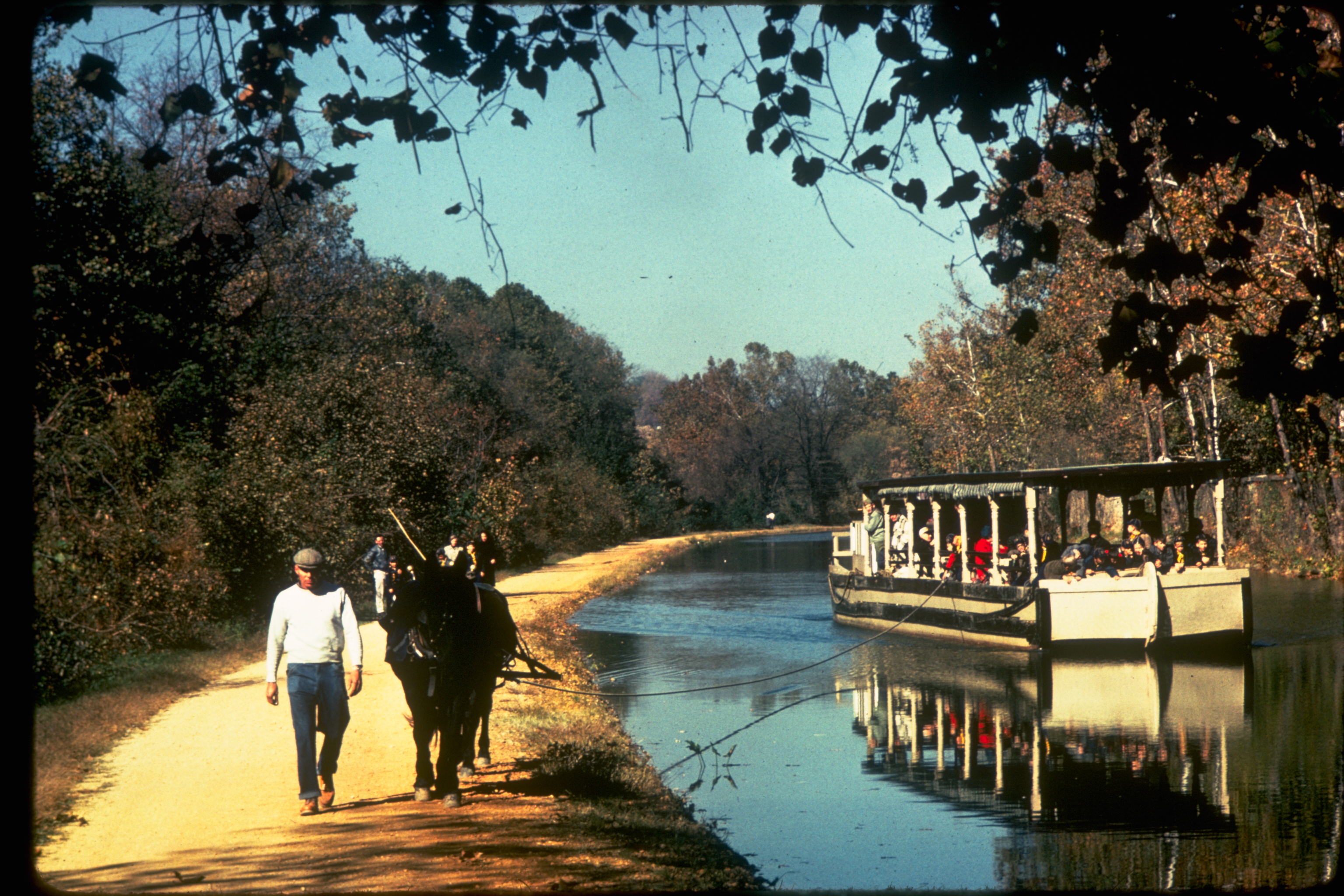
RELATED: 10 EPIC Illinois National Parks
8. Chesapeake Bay Watershed
The Chesapeake Bay Watershed is a large and complex network of rivers, streams, and wetlands that drain into the Chesapeake Bay, one of the largest estuaries in the United States.
The watershed covers over 64,000 square miles and encompasses parts of six states, including New York, Pennsylvania, Maryland, Virginia, West Virginia, and Delaware.
The Chesapeake Bay Watershed is a critical ecosystem, supporting a wide variety of wildlife, including fish, birds, and mammals, as well as numerous plant species.
The watershed is also an important resource for human communities, providing water for drinking, irrigation, and industrial uses, as well as supporting fishing, boating, and other recreational activities.

Today It Confronts Significant Environmental Challenges
Despite its importance, the Chesapeake Bay Watershed has faced significant environmental challenges in recent decades, including pollution, habitat loss, and overfishing.
In response to these challenges, the Chesapeake Bay Program was established in 1983 as a regional partnership to protect and restore the health of the bay and its watershed.
Today, the Chesapeake Bay Program is working to protect and restore the health of the bay and its watershed through a combination of regulation, restoration efforts, and public education and outreach.
The program is focused on reducing pollution, restoring habitats, and promoting sustainable land use practices in the watershed, in order to ensure the long-term health and resilience of the bay and its ecosystem.
.jpg)
RELATED: 4 EPIC Indiana National Parks
9. Civil War Defenses Of Washington
If you love history in general and the history of the American Civil War in particular then Maryland National Parks will not disappoint. A case in point is the Civil War Defenses Of Washington. Perhaps a short history lesson is in order.
During our nation’s bloodiest conflict, one of President Abraham Lincoln’s greatest worries was that Confederate forces would capture Washington, D.C. For the South, our nation’s capitol was the elusive prize that might have brought the southern states their independence.
To prevent this from happening, 68 forts and 93 batteries armed with over 800 cannons encircled Washington, D.C.

A Complex System Of Civil War Fortifications
Along forested hills surrounding the nation’s capital, visitors can see the remnants of a complex system of Civil War fortifications.
Nineteen of these original sites are now managed by the National Park Service. Among these are included:
- 122nd New York Infantry at Battleground National Cemetery
- 150th Ohio National Guard Infantry Monument
- 98th Pennsylvania Volunteer Infantry Monument
- Battery (Fort) Ricketts which was constructed as part of the Eastern Branch Line Defenses (Anacostia River).
- Battery Kemble which held two 100-pounder Parrott rifles, placed in such a way as to sweep Chain Bridge along the Potomac River and the Virginia shoreline.
- Battleground National Cemetery established shortly after the Battle of Fort Stevens, in the summer of 1864. This battle marked the defeat of General Jubal A. Early’s Confederate campaign to launch an offensive action against the nation’s capital.
And that’s only a part of the total number of sites which still remain to be explored.
_FSTV_CWDW-0058.jpg)
RELATED: 6 (EPIC) Kentucky National Parks For Your Visit To The Bluegrass State
To Learn More About The Civil War
So many books have been written about the Civil War and the various battles that took place.
Of course, the big three authors when it comes to war are, in my humble opinion, Bruce Catton, Shelby Foote and James M. McPherson.
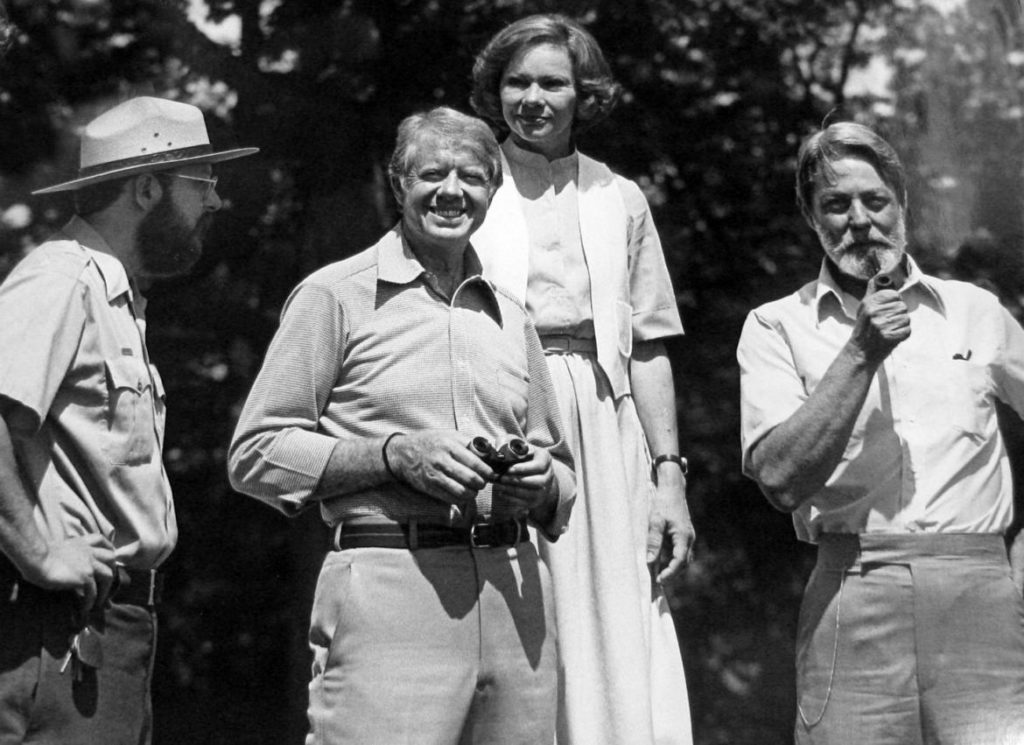
What these three have written are the best collections of books encompassing the war as a whole. You can’t go wrong with any of these authors. My personal favorite is Shelby Foote. I have read his fabulous three volume history of the Civil War–twice!
Check Out: 10 BEST Civil War Sites In America
More Maryland National Parks
10. Clara Barton National Historic Site
Our next Maryland National Park site moves us from taking lives to saving them.
Clara Barton is one of the most honored women in American history and rightly so.
During the American Civil War, Barton became known as an “Angel of the Battlefield.” She courageously provided nursing care and supplies to soldiers. She found other ways to help the military too.
With permission from President Lincoln, she opened the Office of Missing Soldiers, helping to reconnect more than 20,000 soldiers with their families.
Clara Barton’s compassion extended beyond the boundaries of her native land. She went on to volunteer with the International Committee of the Red Cross, providing civilian relief during the Franco-Prussian War.

Her greatest accomplishment, however, was the establishment of the American Red Cross on May 21, 1881.
Clara Barton served as first president of this organization Red Cross for 23 years, retiring in 1904. She died at her home in Glen Echo, Maryland, on April 12, 1912.

Things To Do At The Clara Barton National Historic Site
The National Park Service has restored eleven rooms, including the Red Cross offices, parlors and Clara Barton’s bedroom.
Visitors to Clara Barton National Historic Site can see how Barton lived and worked surrounded by all that went into her life’s work.
Visitors are led through the three levels on a guided tour emphasizing Barton’s use of her unusual home. There are 9 acres of land at her Glen Echo home including the 38-room former residence of Barton.
.jpg/800px-Clara_Barton_House%2C_interior_(21439761408).jpg)
RELATED: 9 EPIC Mississippi National Parks
11. Check Out Fort Foote Park
One of the lesser known of the Maryland National Parks is Fort Foote Park.
Fort Foote Park is a historic site located in Oxon Hill, Maryland, near the Potomac River. The park is named after Fort Foote, a former Union Army fort that was built during the American Civil War to defend the capital from Confederate attack.
The fort was constructed in 1863 and served as an important part of the Union Army’s defenses of Washington, D.C. Throughout the Civil War, the fort was used as a lookout post and as a staging ground for attacks against Confederate forces in Virginia.
Today, Fort Foote Park is a popular destination for history enthusiasts and outdoor lovers, offering a range of recreational opportunities and educational programs. The park is home to several historic sites, including the fort and several earthwork batteries that were used to defend the fort and the Potomac River during the Civil War.
Visitors to the park can explore the fort’s remaining structures, including its earthworks and magazines, as well as several interpretive displays that provide information about the fort’s history and its role in the Civil War.
The park also offers several hiking trails, picnic areas, and scenic overlooks, providing opportunities for outdoor recreation and enjoyment of the park’s natural beauty.
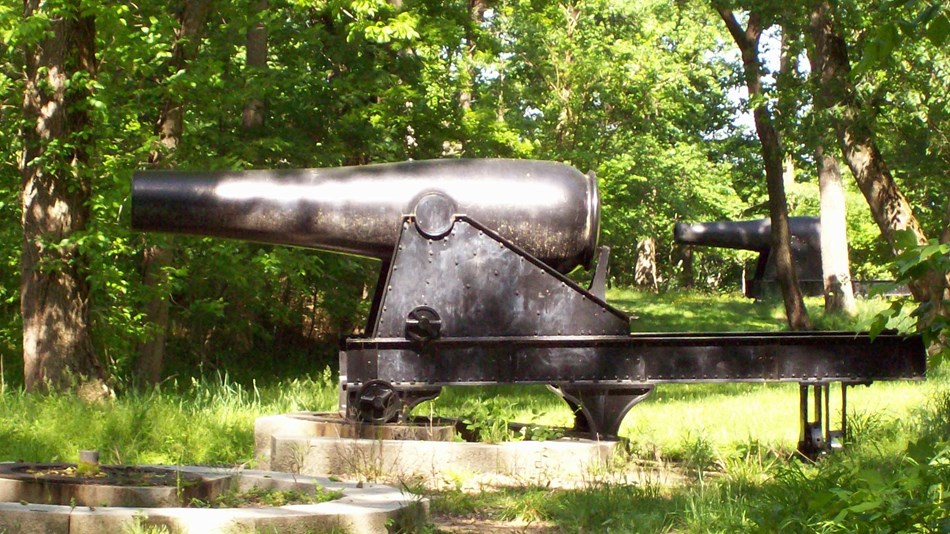
RELATED: 6 GREAT Missouri National Parks
12. Visit Fort McHenry National Monument & Historic Shrine
What a story this Maryland National Park site has to tell! Immortalized by Francis Scott Key during the War of 1812. “O! say can you see . . .“
Fort McHenry National Monument & Historic Shrine is best known as the birthplace of the Star-Spangled Banner, the American national anthem.
The fort was built in the late 1700s and played a critical role in the War of 1812. During the Battle of Baltimore in September 1814, the fort withstood a relentless bombardment by the British navy, inspiring Francis Scott Key to write the words to the Star-Spangled Banner.
Today, Fort McHenry National Monument & Historic Shrine is a popular destination for history enthusiasts, offering a range of educational opportunities and recreational activities. Visitors can explore the fort’s history through exhibits, ranger-led tours, and interactive programs, as well as hike the trails and picnic in the park.
The fort has been restored to its appearance during the War of 1812, and visitors can explore the ramparts, barracks, and other structures, learning about the fort’s history and its role in the defense of Baltimore and the nation.
The site also includes a museum and a visitor center, where visitors can learn about the fort’s history and the War of 1812, as well as see original artifacts and interactive exhibits.
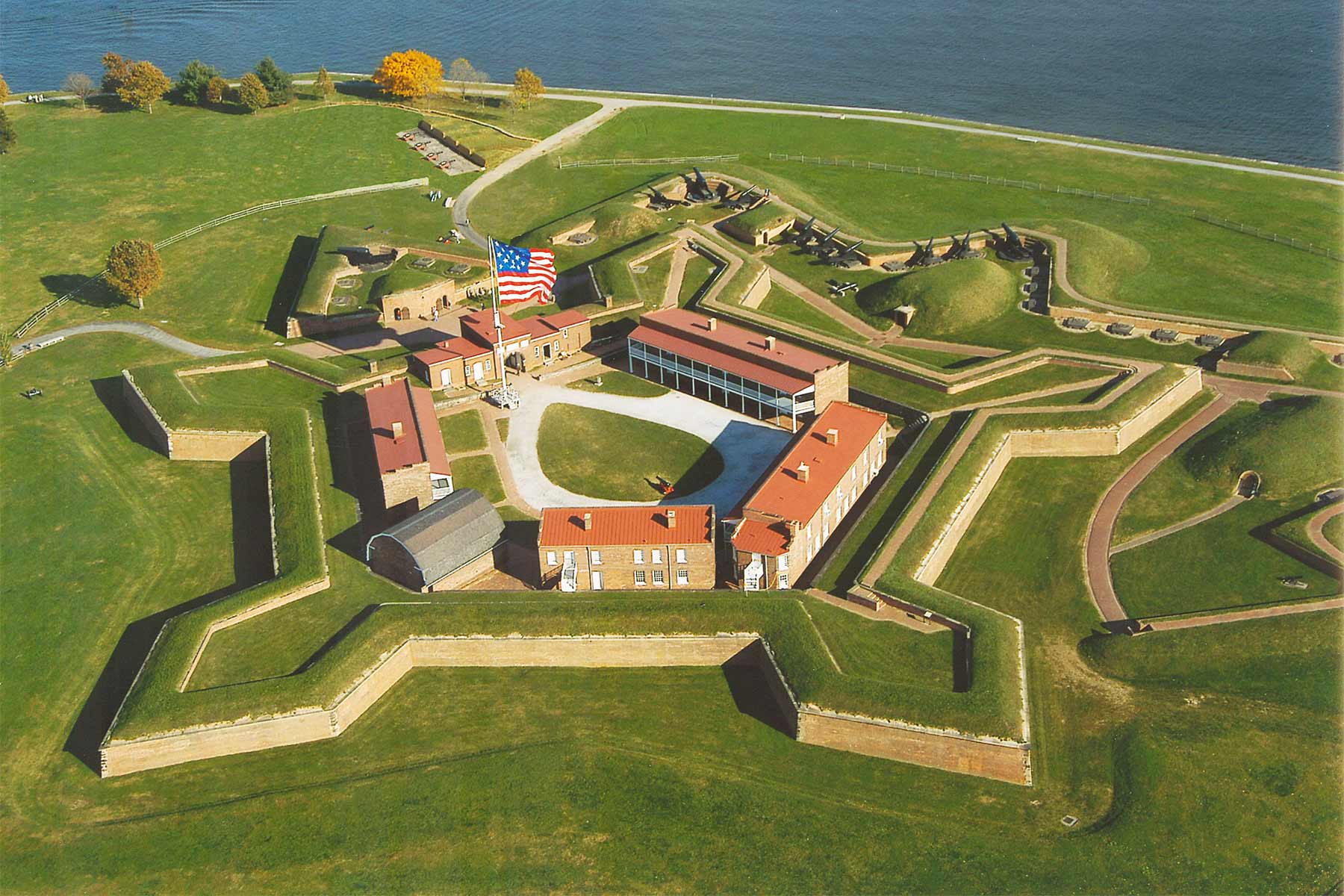
RELATED: 10 [EPIC] Montana National Parks
Explore Fort McHenry
I recommend beginning your adventure at the visitor center where you can see the park movie. It’s a wonderful way to become familiar with the park’s history.
The fort tour is self-guided with informative exhibits to help visitors understand its historical importance.
At the Fort McHenry National Monument and Historic Shrine, spectators can also partake in a variety of programs, including the Fort, Flag and Fire Ceremony every Saturday at 2 p.m. in July and August, which invites spectators to enjoy guided tours and even assist in the changing of the 42-foot flag.
After the history lesson, you can relax on the grounds and enjoy a picnic with the family.
My favorite part of the tour was soaking in the scenic views of the water and brushing up on American history with “flag talks” given by highly informative park rangers.
RELATED: 7 AMAZING Oklahoma National Parks
13. Fort Washington Park
Another of the lesser known Maryland National Parks is Fort Washington Park.
Named after America’s first President of the United States, Fort Washington was built to defend the river approach to Washington, D.C.
The fort was constructed in response to the threat of attack from the British during the American Revolution and was used as a military fortification until the end of the 1800s.
During the Civil War, the fort was used as a Confederate prison camp.

Fort Washington Park Today
Today, Fort Washington Park is a popular destination for history enthusiasts and outdoor lovers, offering a range of recreational opportunities and educational programs.
The park is home to several historic sites, including the fort and several earthwork batteries that were used to defend the fort and the Potomac River during the American Revolution and the Civil War.
Visitors to the park can explore the fort’s remaining structures, including its earthworks and magazines, as well as several interpretive displays that provide information about the fort’s history and its role in the defense of the nation.
The park also offers several hiking trails, picnic areas, and scenic overlooks, providing opportunities for outdoor recreation and enjoyment of the park’s natural beauty.
In addition to its historical and recreational offerings, Fort Washington Park also serves as an important educational resource, offering a range of educational programs and events, including ranger-led hikes and educational workshops.
The park provides visitors with an opportunity to learn about the important role that the fort and its associated earthworks played in the defense of the nation during the American Revolution and the Civil War.

RELATED: 25 EPIC New York National Parks
14. George Washington Memorial Parkway
The George Washington Memorial Parkway is a scenic parkway that runs along the Potomac River in the Washington, D.C. metropolitan area.
The parkway was designed to connect important landmarks and cultural resources in the region, including Mount Vernon, the home of George Washington, and Great Falls Park.
The parkway was established in 1932 and is managed by the National Park Service. It covers approximately 25 miles and provides scenic views of the Potomac River and the surrounding landscape. The parkway is also a popular destination for outdoor recreation, including hiking, biking, and picnicking.
In addition to its recreational offerings, the George Washington Memorial Parkway also provides access to several historic sites, including Fort Hunt Park, Theodore Roosevelt Island, and the Dyke Marsh Wildlife Preserve.
The parkway also provides access to several popular monuments and memorials, including the Lincoln Memorial and the Jefferson Memorial, making it an important cultural resource for the region.
The parkway is known for its beautiful landscapes and scenic views, and it is a popular destination for tourists and locals alike. Whether you are looking to enjoy the outdoors, visit historic sites, or simply enjoy the scenery, the George Washington Memorial Parkway is a destination worth visiting.
RELATED: 12 EPIC North Carolina National Parks
More Maryland National Parks
15. Glen Echo Park
Glen Echo is another fascinating Maryland National Park. For over 100 years, Glen Echo Park has served as a place of amusement and leisure for its visitors.
The park was the dream of Edwin Baltzley whose claim to fame was the egg beater. He invented the device and then went into real estate development with his brother.
In July of 1888, the Baltzley Brothers purchased just over 500 acres that extended from Cabin John Creek and continued eastward along the Potomac River.
Glen Echo Became A Part Of The Chautauqua Movement
Their park became a part of the Chautauqua Movement. This movement began in Chautauqua, New York, in 1874, as an organized way to teach Sunday-school organization, management, and Bible-study.
The National Chautauqua of Glen Echo, the 53rd such assembly to be established, was incorporated in February 1891, for “the purpose of establishing and maintaining an institution of Learning to be conducted upon the Chautauqua idea and plan.”
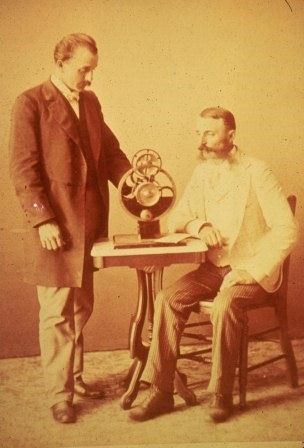
In 1911, the Washington Railway and Electric Company was operating the trolley line from Washington, D.C. to Glen Echo and they were looking for a way to increase ridership on that particular line.
The company purchased the site and Glen Echo Amusement Park was born. (Source: NPS)
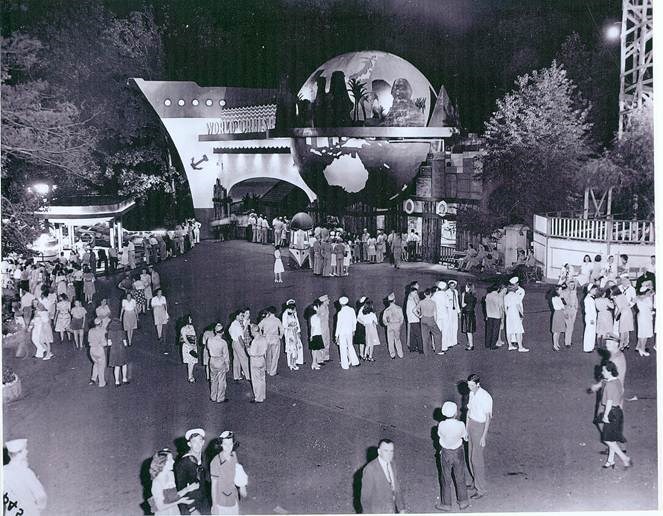
Glen Echo And The Summer Of Change
Believe or not, Glen Echo became a part of the Civil Rights Movement of the 1960s.
In the spring of 1960, a group of students organized themselves as the “Non-violent Action Group” (NAG) and began protesting Northern Virginia lunch counters, restaurants, and department stores.
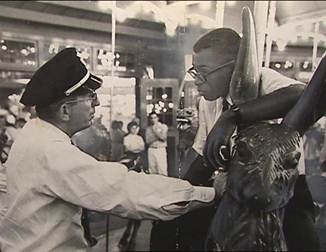
During the summer of 1960, they came to Glen Echo Amusement Park. On the evening of June 30, Laurence Henry, a 26 year old Howard University student, led approximately two dozen NAG members, both black and white, and two high school students on a protest of Glen Echo Amusement Park.
With the support of Attorney General Robert Kennedy, on March 14, 1961, announcement that the park would open its doors to any patron, regardless of skin color.

RELATED: 5 MUST-SEE Historic Sites In Alabama
Glen Echo Becomes A National Park
The General Services Administration officially acquired the title to Glen Echo Park on April 1, 1970. The Glen Echo tract and title was officially transferred to the National Park Service on March 5, 1976.
Today Glen Echo Park is an arts and culture park. As for the amusement park, the only ride remaining is the carousel.

RELATED: 12 EPIC Oregon National Parks You’ll Love
16. Greenbelt Park
Greenbelt Park is a public park located in Greenbelt, Maryland, USA. It is part of the National Park System and covers an area of approximately 1,100 acres.
The park offers a variety of recreational opportunities such as hiking trails, picnic areas, and campgrounds.
There are also several historic sites within the park, including a Civilian Conservation Corps Museum and several stone picnic shelters built in the 1930s.
The park is surrounded by forests and is a popular spot for birdwatching and wildlife observation.
17. Hampton National Historic Site
Hampton National Historic Site is a former plantation and mansion located in Towson, Maryland.
The estate was built in the late 1700s and served as a residence for several generations of the Ridgely family. It features Georgian-style architecture, a formal garden, and a working farm.
The site was designated a National Historic Site in 1948 and is now maintained by the National Park Service as a museum that showcases the history and lifestyles of the wealthy landowners who lived there.
Visitors can take guided tours of the mansion and grounds, as well as participate in educational programs and special events.
.jpg)
18. Harmony Hall
One of the most intriguing of the Maryland National Parks is Harmony Hall.
Harmony Hall is a historic plantation house located in Fort Washington, Maryland, USA. The house was built in the mid-1700s and was owned by several prominent families over the years, including the Addison, Digges, and Bowie families.
During the Civil War, the house served as a hospital for Confederate soldiers and was used as a headquarters for Union troops.
After the war, the property was divided and sold off.
In the 20th century, the house fell into disrepair and was nearly demolished, but was saved and restored by the Prince George’s County government in the 1960s.
Today, Harmony Hall is open to the public as a museum and cultural center, showcasing the history of the plantation, its owners, and the surrounding community.
Visitors can take guided tours of the house and grounds and participate in educational programs and events.

19. Harpers Ferry National Historical Park
As a retired history teacher and lifelong history buff, Harpers Ferry National Historical Park is one of my favorite Maryland National Parks.
In the 1790s, the U.S. government established a national armory and arsenal at Harpers Ferry, which was a major center for the manufacture and storage of weapons for nearly a century.
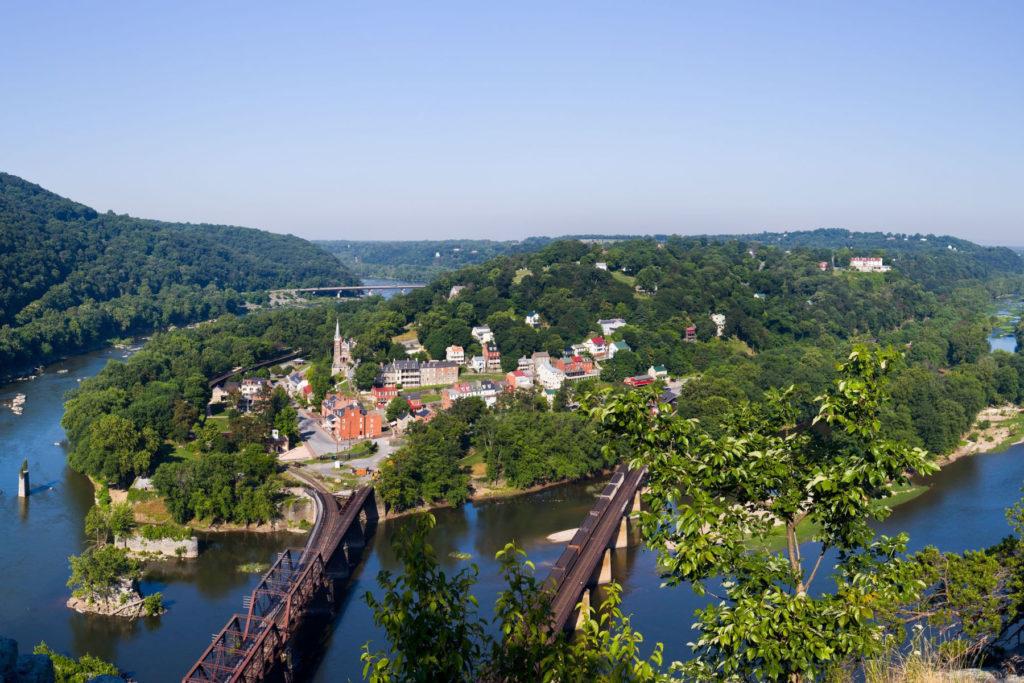
John Brown’s Raid On Harpers Ferry
John Brown’s raid on Harpers Ferry was a significant event in American history and had far-reaching consequences.
Brown’s attack on the federal armory was seen by many as a direct challenge to the institution of slavery and helped to further polarize the nation on the issue.
While the raid was ultimately unsuccessful, it is widely recognized as a catalyst for the American Civil War and a turning point in the country’s struggle over the issue of slavery.
Today, John Brown is remembered as a controversial figure, with some seeing him as a martyr for the abolitionist cause, and others viewing him as a dangerous radical who used violence to achieve his goals.
Regardless of one’s perspective, his actions at Harpers Ferry had a lasting impact on American history and continue to be studied and debated to this day.
Things To Do At Harpers Ferry
Harpers Ferry National Historical Park offers a variety of activities and experiences for visitors, including:
- Tour historic buildings and museums: The park includes a number of historic buildings, such as John Brown’s Fort and the Armory Museum, which provide a window into the rich history of Harpers Ferry and the events that took place there.
- Hiking and outdoor recreation: The park boasts over 20 miles of hiking trails, providing scenic views of the Potomac and Shenandoah rivers, as well as the surrounding mountains.
- Interpretive programs: The park offers a range of ranger-led programs, including guided tours, talks, and living history demonstrations, which help visitors understand and appreciate the history of Harpers Ferry.
- Canoeing and kayaking: Visitors can rent canoes or kayaks and explore the Potomac and Shenandoah rivers for a unique perspective on the area.
- Civil War history: Harpers Ferry played an important role during the Civil War and is home to several monuments and markers dedicated to this period of American history.
- Shopping and dining: The park also has a number of shops and restaurants that offer a range of souvenirs, gifts, and food options.
- Photography: With its stunning scenery and historic buildings, Harpers Ferry is a popular destination for photographers and offers many opportunities to capture beautiful images.
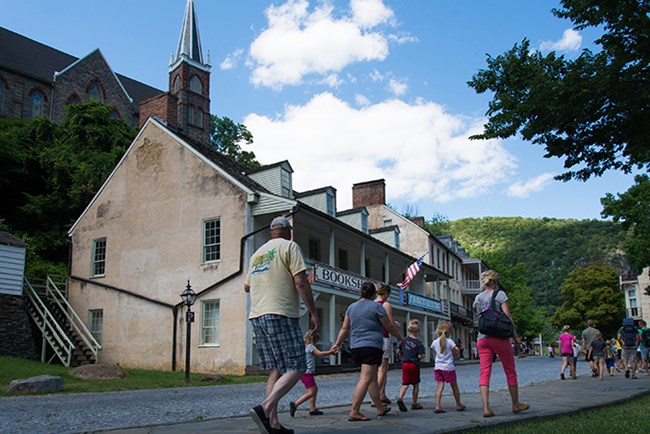
While You’re There, Check Out The Appalachian Trail
If you’re looking to combine history and nature then check out the 22 miles of hiking trails at Harpers Ferry. It happens to be the mid-point of the 2,178-mile Appalachian Trail.
Picnicking is also available at Harpers Ferry National Historical Park at a designated picnic area adjacent to the Visitor Center parking lot. Picnic tables are on a first-come, first-serve basis.
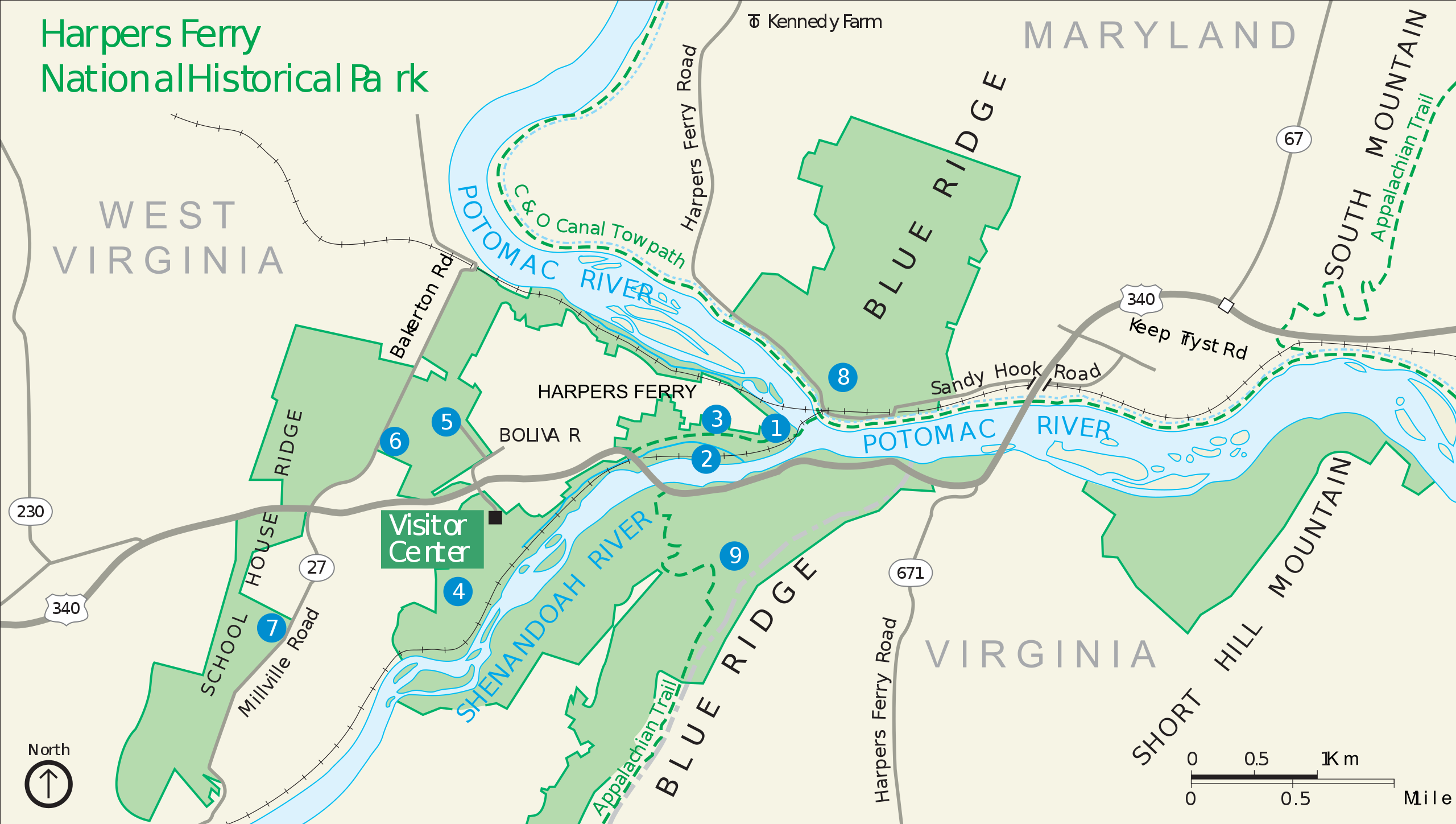
More Maryland National Parks
20. Harriet Tubman Underground Railroad National Historical Park
The Harriet Tubman Underground Railroad National Historical Park is dedicated to the memory of Harriet Tubman, who escaped slavery and became a leader in the Underground Railroad. The park was established in 2013 to preserve the history of the Underground Railroad and the role that Harriet Tubman played in it.
Harriet Tubman was born into slavery in Maryland in the early 1820s and escaped to freedom in Philadelphia in 1849. She then returned to the South multiple times to help other slaves escape to freedom on the Underground Railroad. The Underground Railroad was a secret network of safe houses and escape routes used by slaves to escape to freedom in the North or Canada.
The Harriet Tubman Underground Railroad National Historical Park preserves several sites associated with Tubman’s life, including the Thompson’s Store, where she is believed to have started her work on the Underground Railroad, and other properties where she may have lived or worked.
Visitors can explore the park’s trails and learn about the history of slavery and the Underground Railroad through exhibits and ranger-led programs.
The park also serves as a testament to Tubman’s remarkable life and her contributions to the struggle for freedom and equality. Today, the park is an important site for learning about and honoring the legacy of Harriet Tubman and the Underground Railroad.
Check Out: 10 BEST Civil Rights Sites In America
21. Monocacy National Battlefield
Monocacy National Battlefield is located in Frederick County, Maryland and is the site of the Battle of Monocacy, which was fought on July 9, 1864, during the American Civil War.
The battle was a Confederate victory that delayed Union General Ulysses S. Grant’s plans to attack the Confederate capital of Richmond, Virginia. Despite the Confederate victory, the battle is considered a turning point in the Civil War because it bought time for the defense of Washington, D.C.
The site was largely neglected in the decades that followed the Civil War, but in the early 20th century, efforts began to preserve the site as a historical landmark.
In the 1930s, the Works Progress Administration provided funding for the restoration and preservation of the battlefield.
In the 1960s, the National Park Service acquired the land and established Monocacy National Battlefield as a unit of the National Park System.
The site now includes several monuments and interpretive trails, and is open to the public for visiting and educational programs.
.jpg)
Things To Do At Monocacy National Battlefield
Visitors to the Monocacy National Battlefield will explore 1,647 acres of rolling farm fields, historic buildings, and sweeping panoramas along the scenic Monocacy River.
There are seven walking trails. Some provide scenic walks whereas others cover phases of the battle.
You can also take a leisurely 5-mile round trip hike around the northern section of Rock Creek Park.
If you prefer driving, however, there’s a self-guided auto tour. The auto tour has five stops, all of which are key locations related to the Battle of Monocacy. The route follows public roads and totals about six miles round-trip.
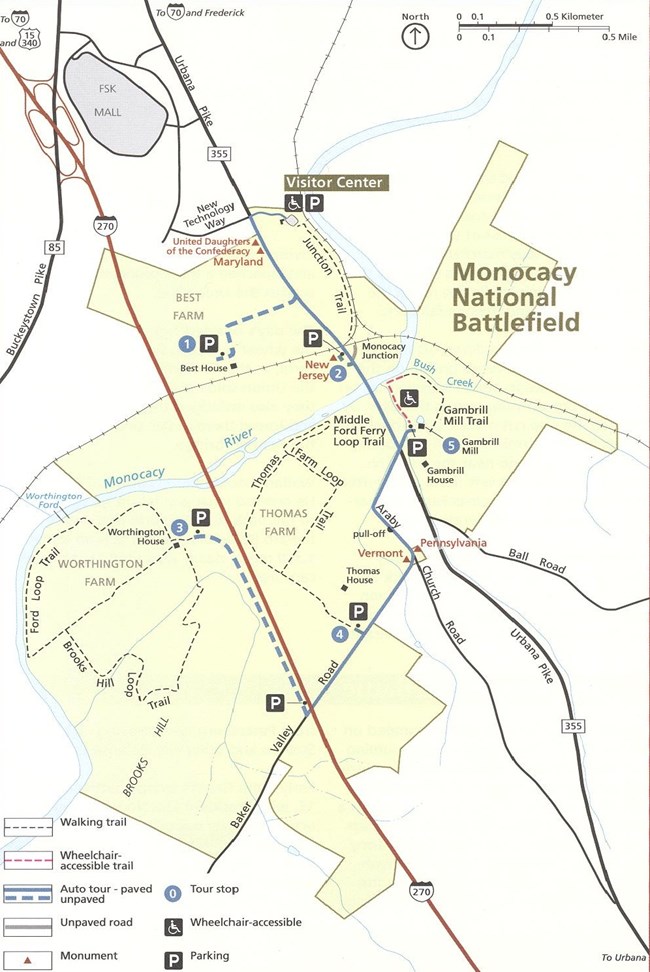
22. Oxon Cove Park & Oxon Hill Farm
Who doesn’t love animals. Especially if you’re not the one who has to care for them. One of the most fun Maryland National Parks is Oxon Cove Park & Oxon Hill Farm.
At Oxon Hill Farm you can take a self guided tour of the farmyard to see the cows, pigs, horses, sheep, goats, and chickens. Watch where you step!
While you’re there you’ll also notice antique farm equipment, historic structures, and informational outdoor exhibit placards. Stop by the Visitor Barn to pick up a Self-Guided Walking Tour.
Or you can check out Oxon Cove Park’s 512 acres. You can bike, hike, jog or walk along the lower fields or riding the bike path along Oxon Cove.
It’s also a great place to have a picnic. There are first come, first serve picnic tables next to the parking lot. Please be sure to dispose of all litter properly.

23. Piscataway Park
If you’re looking for a lovely place to spend the day then why not visit Piscataway Park? If you enjoy watching wildlife it’s home to bald eagles, beavers, deer, foxes, ospreys, and many other species.
The park also has a public fishing pier and two boardwalks over fresh water tidal wetlands, a variety of nature trails, meadows, and woodland areas.
While you’re there you should also check out the National Colonial Farm. It’s a historic farm museum that demonstrates 18th century agriculture.
.jpg)
24. Potomac Heritage National Scenic Trail
Imagine a trail that has something for everyone. History, nature, recreation, wildlife, biking, hiking, paddling or just enjoying a quiet getaway for the hustle and bustle of an urban world.
Here’s a Maryland National Park where you can escape the cares and worries of day-to-day existence and be one with nature instead.
On the Potomac Heritage National Scenic Trail you can find your own special outdoor adventure.
Still More Maryland National Parks
25. Star-Spangled Banner National Historic Trail
According to the National Park Service, The Star-Spangled Banner National Historic Trail, established by Congress in 2008, is a 560-mile land and water route that tells the story of the War of 1812 in the Chesapeake Bay region.
The trail traces American and British troop movements, introduces visitors to communities affected by the war, and highlights the Chesapeake region’s distinctive landscapes and waterways.
It connects historic sites in Maryland, Virginia, and the District of Columbia and commemorates the events leading up to the Battle for Baltimore, the aftermath of which inspired Francis Scott Key to write the U.S. national anthem.
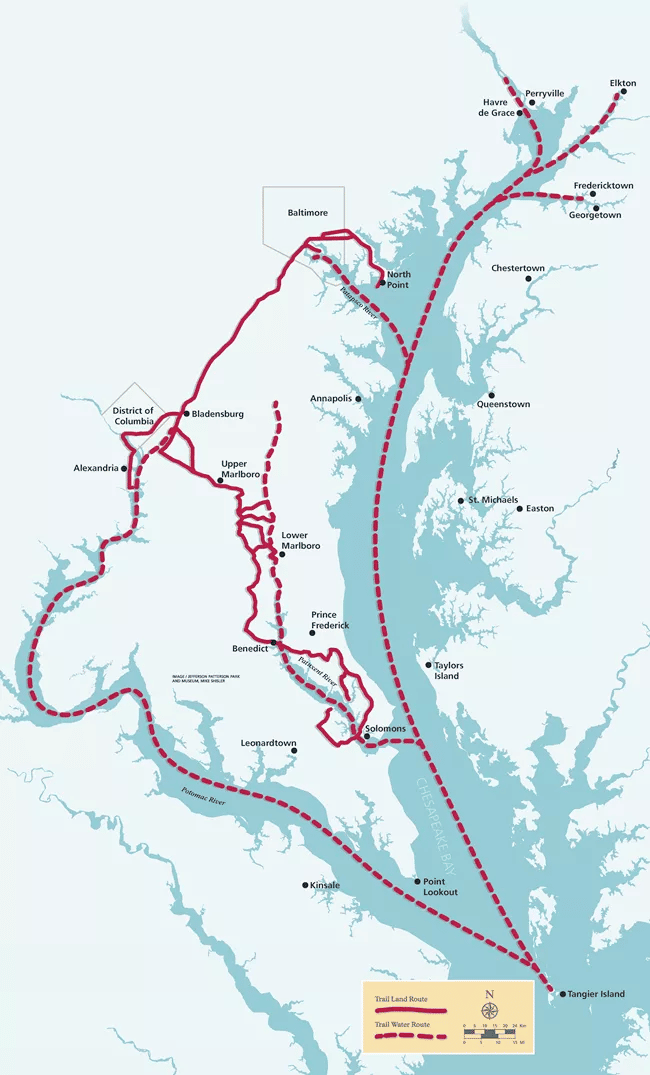
Points of interest include:
- Flag Raising at Fort McHenry
- Star-Spangled Banner Flag House and Museum
- Jefferson Patterson Park & Museum
- Fort Washington
- Concord Point Lighthouse
- North Point Beachhead War of 1812 Historic Sign
26. The Thomas Stone National Historic Site
Three’s a Maryland National Parks dedicated to a signer of the Declaration of Independence.
One of the 56 signers of the Declaration of Independence was Thomas Stone.
He was among the men who pledged their “lives, fortunes, and sacred honor” to give birth to the United States of America.
After the fighting at Lexington and Concord, Stone wanted to give King George III an opportunity to bring about peace without revolution.
He was one of a group of men who supported the Olive Branch Petition, which informed the king of the continued support of the colonists, but the king refused to read it and declared the colonies to be in rebellion.
While Stone lived to see the 13 Colonies victorious in the American Revolution, he died in 1787 and was therefore not able to be a part of the Constitutional Convention which created the current government of the United States.
Stone’s greatest contribution to the revolutionary cause was his support of the Declaration of Independence in 1776.

Things To Do At The Thomas Stone National Historic Site
Visitors can take a wonderful walking 1.5 mile trail called the Outbuildings Trail.
It goes past Horse Barn and passes the Tenant House, the Corn Crib and the Tobacco Barn. It connects with the Stone Family Cemetery trail.
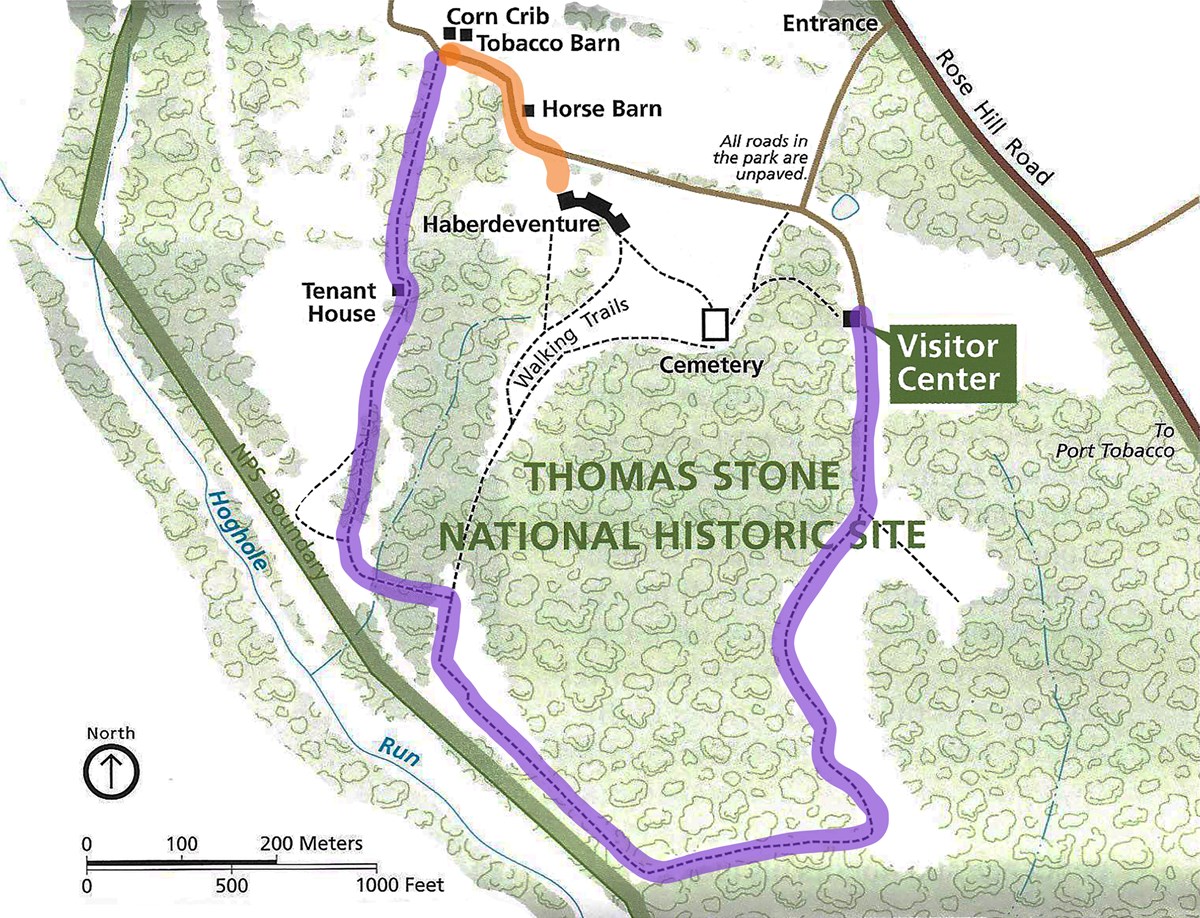
27. Washington-Rochambeau Revolutionary Route National Historic Trail
We have arrived at the last of the Maryland National Parks on our list! And what a list it has been!
George Washington’s ultimate success against the British was made possible through an alliance with France.
On July 11, 1780, 55-year-old General Jean Baptiste Donatien de Vimeur, comte de Rochambeau arrived with an army of 450 officers and 5,300 men in Narragansett Bay off Newport, Rhode Island.
This marked the beginning of a most successful military cooperation that culminated 15 months later in the victory at Yorktown and the surrender of Lord Cornwallis and his troops.
From New Hampshire to Virginia, the Washington-Rochambeau National Historic Trail connects major metropolitan areas, state and national parks, historic and scenic trails, and countless other historic sites.
The rout is a 680-mile series of roads used in 1781 by the Continental Army under the command of George Washington and the forces under the command of Admiral Rochambeau during their 14-week march from Newport, Rhode Island, to Yorktown, Virginia.
Check Out Our Great Smoky Mountains Film
MTJP | Smoky Mountains is a visually stunning journey through Great Smoky Mountain National Park during peak fall color.
This video is the culmination of two weeks exploring Great Smoky Mountains National Park. We chose Great Smoky Mountains as our second park because of it’s extraordinary display of fall colors, it’s incredibly diverse wildlife population, and it’s importance as the most visited national park in the country.
This film was shot entirely in 4K UHD. We chose to capture this park in the Fall as it is home to one of the most wonderful displays of fall foliage on the planet.
Fall is also a wonderful time to watch the elk rutting season and experience cooler, less humid temperatures.
Learn More About Maryland With These Exciting Book Recommendations

We’re More Than Just Parks which means we’re more than just parks. We believe that it’s not about the destination. Rather, it’s about the journey.
And it’s a journey of the body and the mind which is why we love to give you the opportunity to take a deeper dive so that you can learn about the history behind these special places.
With that in mind, we’ve got some wonderful book recommendations for you:
- Crossroads of Freedom: Antietam by James M. McPherson.
- Blazing Ahead: Benton MacKaye, Myron Avery, and the Rivalry That Built the Appalachian Trail by Jeffrey H. Ryan.
- Assateague Island A Guide to Assateague Island National Seashore Maryland and Virginia by William H. Amos.
- Captain John Smith: Writings with Other Narratives of Roanoke, Jamestown, and the First English Settlement of America by Captain John Smith.
- Woman of Valor: Clara Barton and the Civil War by Stephen B. Oates.
- What So Proudly We Hailed: Francis Scott Key, A Life by Marc Leepson.
- John Brown, Abolitionist: The Man Who Killed Slavery, Sparked the Civil War, and Seeded Civil Rights by David S. Reynolds.
- Harriet, The Moses of Her People: A Biography of Harriet Tubman by Sarah Hopkins Bradford.
- Fighting for Time: The Battle of Monocacy by Glenn H. Worthington.
- Washington-Rochambeau Revolutionary Route and the Franco-American Alliance by Donna Passmore and Jan Smulcer.
RELATED: 45 Best National Parks Books
Maryland National Parks FAQ
Home to the Chesapeake Bay, Maryland is known for its blue crabs and the city of Baltimore, a major historic trading port, baseball power and birthplace of the national anthem.
The following is a list of must-see historic sites in Maryland:
Antietam National Battlefield
Harriet Tubman Underground Railroad National Historical Park
Harpers Ferry National Historical Park
Fort McHenry National Monument & Historic Shrine
Chesapeake & Ohio Canal National Historical Park
Captain John Smith Chesapeake National Historical Trail
Clara Barton National Historic Site
Star-Spangled Banner National Historic Trail
Monocacy National Battlefield
Washington-Rochambeau Revolutionary Route National Historic Trail
Frederick Douglass Museum and Cultural Center
B&O Railroad Museum
Benjamin Banneker Historical Park and Museum
National Museum of Civil War Medicine
Edgar Allan Poe House and Museum
Why Trust Us About Maryland National Parks?
We’re Jim Pattiz and Will Pattiz, collectively known as the Pattiz Brothers (and sometimes the Parks Brothers) and we absolutely LOVE the national parks.
You should probably know that we don’t just make this stuff up out of thin air. We’ve spent our entire adult lives exploring and filming America’s national parks and public lands.
We’ve worked with the National Park Service, the Department of Interior, USDA, and the U.S. Forest Service for years creating films on important places and issues. Our work has been featured in leading publications all over the world and even some people outside of our immediate family call us experts on the national parks.

Meet The Parks Brothers
Map Of Maryland National Park Sites
List Of Maryland National Park Sites
- Antietam National Battlefield
- Appalachian National Scenic Trail
- Assateague Island National Seashore
- Baltimore-Washington Parkway
- Captain John Smith Chesapeake National Historical Trail
- Catoctin Mountain Park
- Chesapeake & Ohio Canal National Historical Park
- Chesapeake Bay Watershed
- Civil War Defenses Of Washington
- Clara Barton National Historic Site
- The Fort Foote Park
- Fort McHenry National Monument & Historic Shrine
- The Fort Washington Park
- George Washington Memorial Parkway
- Glen Echo Park
- Greenbelt Park
- Hampton National Historic Site
- Harmony Hall
- Harpers Ferry National Historical Park
- Harriet Tubman Underground Railroad National Historical Park
- Monocacy National Battlefield
- Oxon Cove Park & Oxon Hill Farm
- Piscataway Park
- Potomac Heritage National Scenic Trail
- Star-Spangled Banner National Historic Trail
- Thomas Stone National Historic Site
- Washington-Rochambeau Revolutionary Route National Historic Trail
We Hope You’ll Follow Our Journey

Our goal here at More Than Just Parks is to share the beauty of America’s national parks and public lands through stunning short films in an effort to get Americans and the world to see the true value in land conservation.
We hope you’ll follow our journey through the parks and help us to keep them the incredible places that they are. If you’re interested in joining the adventure then please sign up below!
Helpful Articles
Virginia National Parks: 30 Epic Virginia National Parks (Helpful Guide + Photos)
Best East Coast National Parks: 10 Best East Coast National Parks Ranked by Experts
Civil War Sites: Check Out More Than Just Parks Top 10 Civil War Sites
Maryland National Parks, national parks in md, national parks near maryland, national parks of maryland, national parks in maryland, Maryland National Parks, national parks in md, national parks near maryland, national parks of maryland, national parks in maryland, Maryland National Parks, national parks in md, national parks near maryland, national parks of maryland, national parks in maryland, Maryland National Parks, national parks in md, national parks near maryland, national parks of maryland, national parks in maryland, Maryland National Parks, national parks in md, national parks near maryland, national parks of maryland, national parks in maryland, Maryland National Parks, national parks in md, national parks near maryland, national parks of maryland, national parks in maryland,
Maryland National Parks, national parks in md, national parks near maryland, national parks of maryland, national parks in maryland, Maryland National Parks, national parks in md, national parks near maryland, national parks of maryland, national parks in maryland, Maryland National Parks, national parks in md, national parks near maryland, national parks of maryland, national parks in maryland, Maryland National Parks, national parks in md, national parks near maryland, national parks of maryland, national parks in maryland, Maryland National Parks, national parks in md, national parks near maryland, national parks of maryland, national parks in maryland, Maryland National Parks, national parks in md, national parks near maryland, national parks of maryland, national parks in maryland,

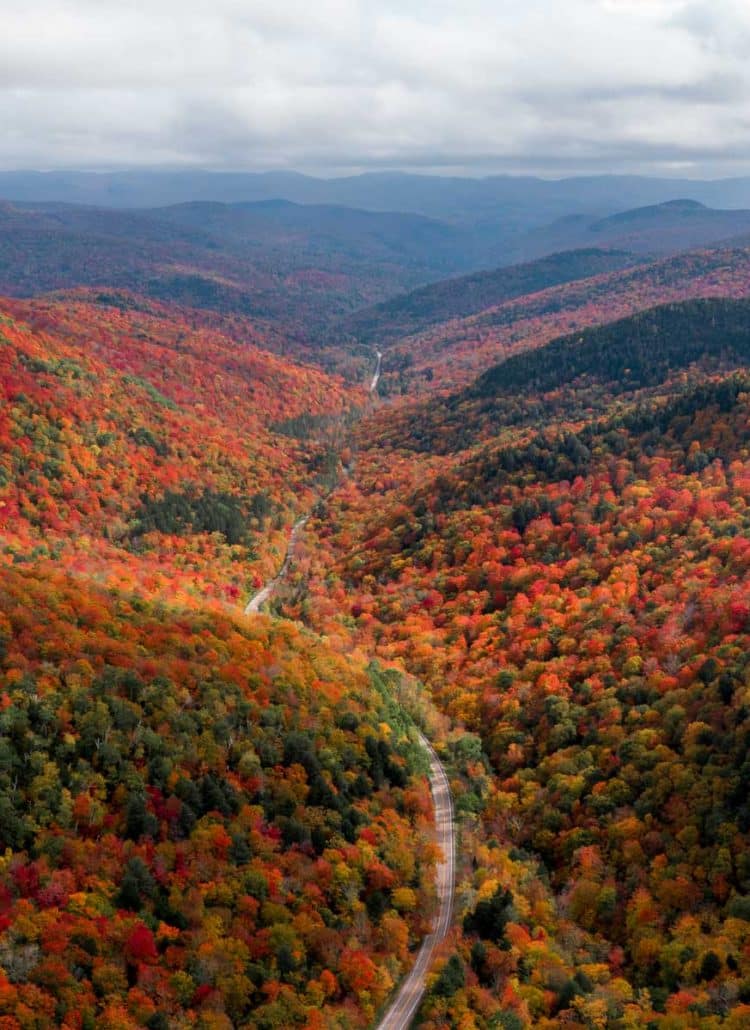
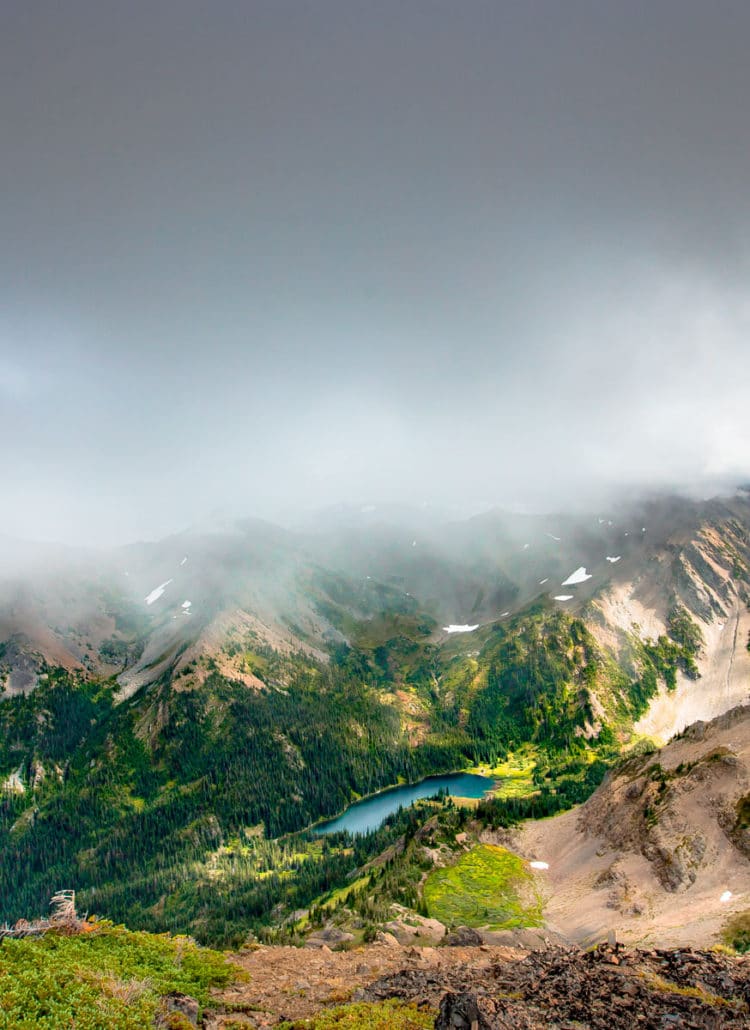
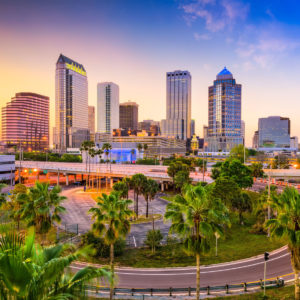

Leave a Reply